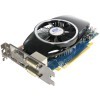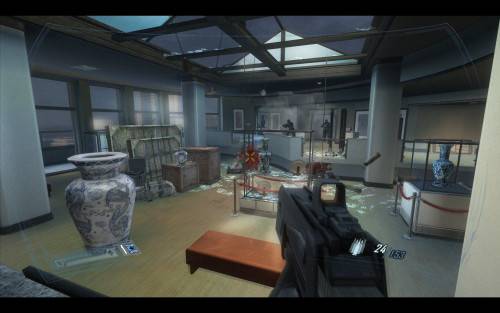- Qualcomm Launches Snapdragon 4 Gen 2 Mobile Platform
- AMD Launches Ryzen PRO 7000 Series Mobile & Desktop Platform
- Intel Launches Sleek Single-Slot Arc Pro A60 Workstation Graphics Card
- NVIDIA Announces Latest Ada Lovelace Additions: GeForce RTX 4060 Ti & RTX 4060
- Maxon Redshift With AMD Radeon GPU Rendering Support Now Available
Sapphire Radeon HD 5750

For a graphics card that retails for a suggested $130, the Radeon HD 5750 sure packs in a lot of features. In addition to its solid performance and superb power consumption, the card supports multiple monitor outputs, DirectX 11, Eyefinity and more. To top it all off, Sapphire includes a voucher for a free copy of Dirt 2 right in the box.
Page 6 – F.E.A.R. 2: Project Origin
Five out of the seven current games we use for testing are either sequels, or titles in an established series. F.E.A.R. 2 is one of the former, following up on the very popular First Encounter Assault Recon, released in fall of 2005. This horror-based first-person shooter brought to the table fantastic graphics, ultra-smooth gameplay, the ability to blow massive chunks out of anything, and also a very fun multi-player mode.
Three-and-a-half years later, we saw the introduction of the game’s sequel, Project Origin. As we had hoped, this title improved on the original where gameplay and graphics were concerned, and it was a no-brainer to want to begin including it in our testing. The game is gorgeous, and there’s much destruction to be had (who doesn’t love blowing expensive vases to pieces?). The game is also rather heavily scripted, which aides in producing repeatable results in our benchmarking.
Manual Run-through: The level used for our testing here is the first in the game, about ten minutes in. The scene begins with a travel up an elevator, with a robust city landscape behind us. Our run-through begins with a quick look at this cityscape, and then we proceed through the level until the point when we reach the far door as seen in the above screenshot.



Things were beginning to look a bit rough for the HD 5750 with our Crysis Warhead test, but F.E.A.R. 2 is helping the card’s road to recovery. Here, the card is consistently faster than the GTS 250. This again isn’t a major surprise, since like Crysis Warhead, F.E.A.R. 2 usually favors ATI cards.
|
Graphics Card
|
Best Playable
|
Min FPS
|
Avg. FPS
|
|
NVIDIA GTX 295 1792MB (Reference)
|
2560×1600 – Max Detail, 4xAA, 16xAF
|
45
|
95.767
|
|
ATI HD 5870 1GB (Reference)
|
2560×1600 – Max Detail, 4xAA, 16xAF
|
65
|
91.34
|
|
ATI HD 5850 1GB (ASUS)
|
2560×1600 – Max Detail, 4xAA, 16xAF
|
51
|
73.647
|
|
NVIDIA GTX 285 1GB (EVGA)
|
2560×1600 – Max Detail, 4xAA, 16xAF
|
39
|
62.014
|
|
NVIDIA GTX 275 896MB (Reference)
|
2560×1600 – Max Detail, 4xAA, 16xAF
|
37
|
57.266
|
|
ATI HD 4890 1GB (Sapphire)
|
2560×1600 – Max Detail, 4xAA, 16xAF
|
38
|
56.726
|
|
ATI HD 4870 1GB (Reference)
|
2560×1600 – Max Detail, 4xAA, 16xAF
|
34
|
50.555
|
|
NVIDIA GTX 260 896MB (XFX)
|
2560×1600 – Max Detail, 4xAA, 16xAF
|
29
|
48.110
|
|
ATI HD 5770 1GB (Reference)
|
2560×1600 – Max Detail, 4xAA, 16xAF
|
31
|
47.411
|
|
ATI HD 5750 1GB (Sapphire)
|
2560×1600 – Max Detail, 0xAA, 16xAF
|
27
|
39.563
|
|
NVIDIA GTX 250 1GB (EVGA)
|
2560×1600 – Max Detail, 4xAA, 16xAF
|
24
|
36.331
|
F.E.A.R. 2 might be a leading PC title where graphics are concerned, but it doesn’t require an ultra-powerful machine for a gamer to experience it at high-end settings. Thanks to this, all of our cards, ranging from $130 up to $500 are able to handle the game at the max detail settings. Better cards will make the game more fluid, of course, but none of these throttle gameplay at those settings.
Support our efforts! With ad revenue at an all-time low for written websites, we're relying more than ever on reader support to help us continue putting so much effort into this type of content. You can support us by becoming a Patron, or by using our Amazon shopping affiliate links listed through our articles. Thanks for your support!






